2006 MERCEDES-BENZ SPRINTER air condition
[x] Cancel search: air conditionPage 2225 of 2305
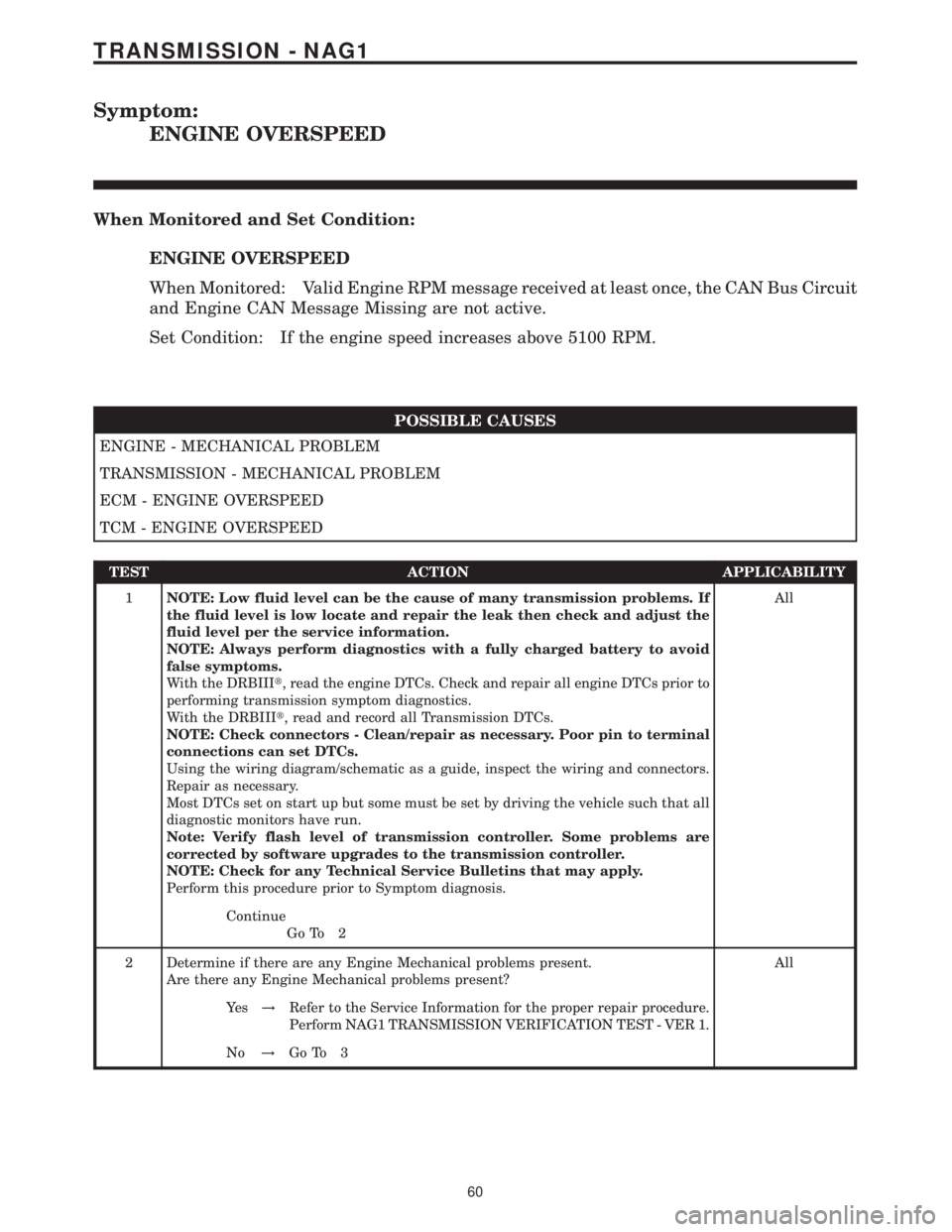
Symptom:
ENGINE OVERSPEED
When Monitored and Set Condition:
ENGINE OVERSPEED
When Monitored: Valid Engine RPM message received at least once, the CAN Bus Circuit
and Engine CAN Message Missing are not active.
Set Condition: If the engine speed increases above 5100 RPM.
POSSIBLE CAUSES
ENGINE - MECHANICAL PROBLEM
TRANSMISSION - MECHANICAL PROBLEM
ECM - ENGINE OVERSPEED
TCM - ENGINE OVERSPEED
TEST ACTION APPLICABILITY
1NOTE: Low fluid level can be the cause of many transmission problems. If
the fluid level is low locate and repair the leak then check and adjust the
fluid level per the service information.
NOTE: Always perform diagnostics with a fully charged battery to avoid
false symptoms.
With the DRBIIIt, read the engine DTCs. Check and repair all engine DTCs prior to
performing transmission symptom diagnostics.
With the DRBIIIt, read and record all Transmission DTCs.
NOTE: Check connectors - Clean/repair as necessary. Poor pin to terminal
connections can set DTCs.
Using the wiring diagram/schematic as a guide, inspect the wiring and connectors.
Repair as necessary.
Most DTCs set on start up but some must be set by driving the vehicle such that all
diagnostic monitors have run.
Note: Verify flash level of transmission controller. Some problems are
corrected by software upgrades to the transmission controller.
NOTE: Check for any Technical Service Bulletins that may apply.
Perform this procedure prior to Symptom diagnosis.All
Continue
Go To 2
2 Determine if there are any Engine Mechanical problems present.
Are there any Engine Mechanical problems present?All
Ye s!Refer to the Service Information for the proper repair procedure.
Perform NAG1 TRANSMISSION VERIFICATION TEST - VER 1.
No!Go To 3
60
TRANSMISSION - NAG1
Page 2227 of 2305
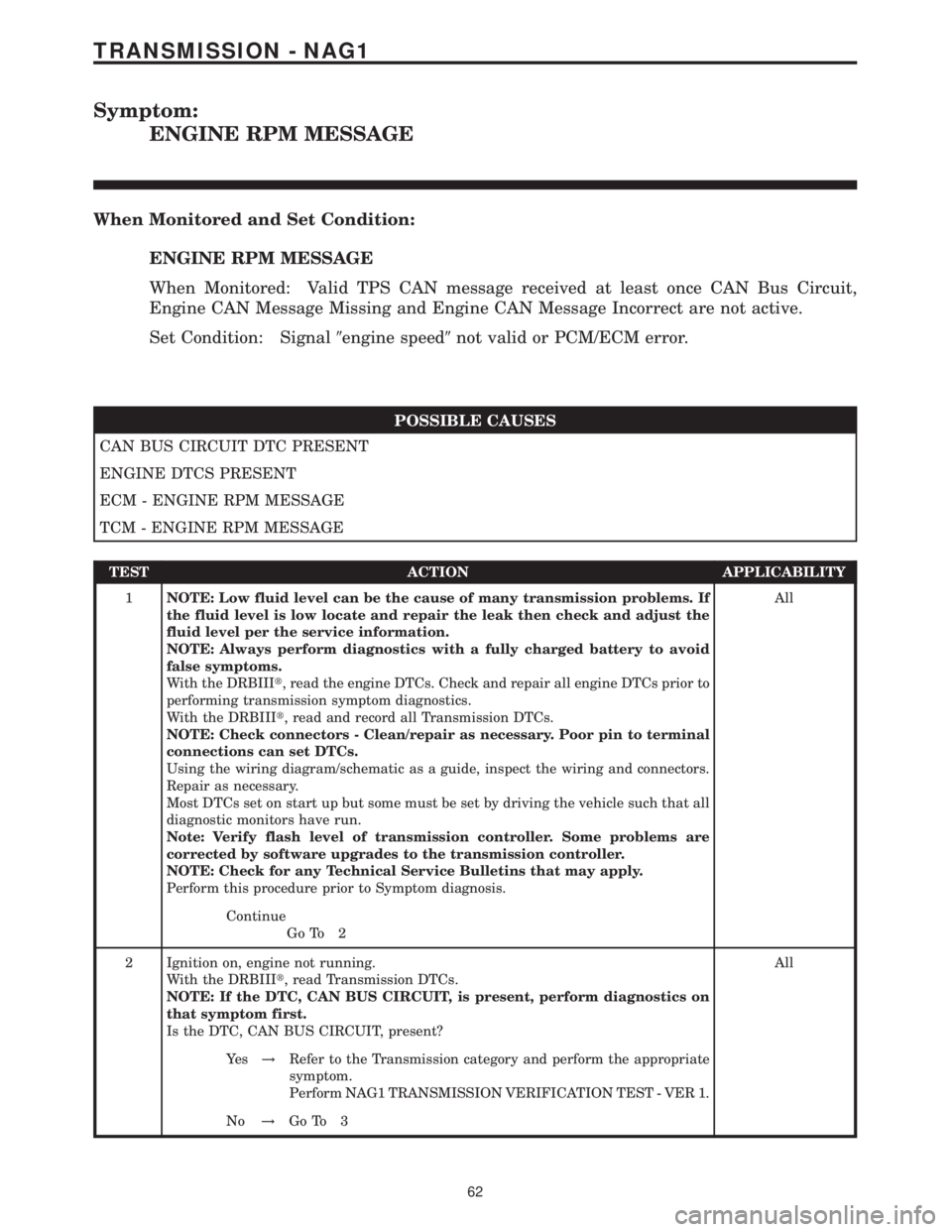
Symptom:
ENGINE RPM MESSAGE
When Monitored and Set Condition:
ENGINE RPM MESSAGE
When Monitored: Valid TPS CAN message received at least once CAN Bus Circuit,
Engine CAN Message Missing and Engine CAN Message Incorrect are not active.
Set Condition: Signal9engine speed9not valid or PCM/ECM error.
POSSIBLE CAUSES
CAN BUS CIRCUIT DTC PRESENT
ENGINE DTCS PRESENT
ECM - ENGINE RPM MESSAGE
TCM - ENGINE RPM MESSAGE
TEST ACTION APPLICABILITY
1NOTE: Low fluid level can be the cause of many transmission problems. If
the fluid level is low locate and repair the leak then check and adjust the
fluid level per the service information.
NOTE: Always perform diagnostics with a fully charged battery to avoid
false symptoms.
With the DRBIIIt, read the engine DTCs. Check and repair all engine DTCs prior to
performing transmission symptom diagnostics.
With the DRBIIIt, read and record all Transmission DTCs.
NOTE: Check connectors - Clean/repair as necessary. Poor pin to terminal
connections can set DTCs.
Using the wiring diagram/schematic as a guide, inspect the wiring and connectors.
Repair as necessary.
Most DTCs set on start up but some must be set by driving the vehicle such that all
diagnostic monitors have run.
Note: Verify flash level of transmission controller. Some problems are
corrected by software upgrades to the transmission controller.
NOTE: Check for any Technical Service Bulletins that may apply.
Perform this procedure prior to Symptom diagnosis.All
Continue
Go To 2
2 Ignition on, engine not running.
With the DRBIIIt, read Transmission DTCs.
NOTE: If the DTC, CAN BUS CIRCUIT, is present, perform diagnostics on
that symptom first.
Is the DTC, CAN BUS CIRCUIT, present?All
Ye s!Refer to the Transmission category and perform the appropriate
symptom.
Perform NAG1 TRANSMISSION VERIFICATION TEST - VER 1.
No!Go To 3
62
TRANSMISSION - NAG1
Page 2229 of 2305
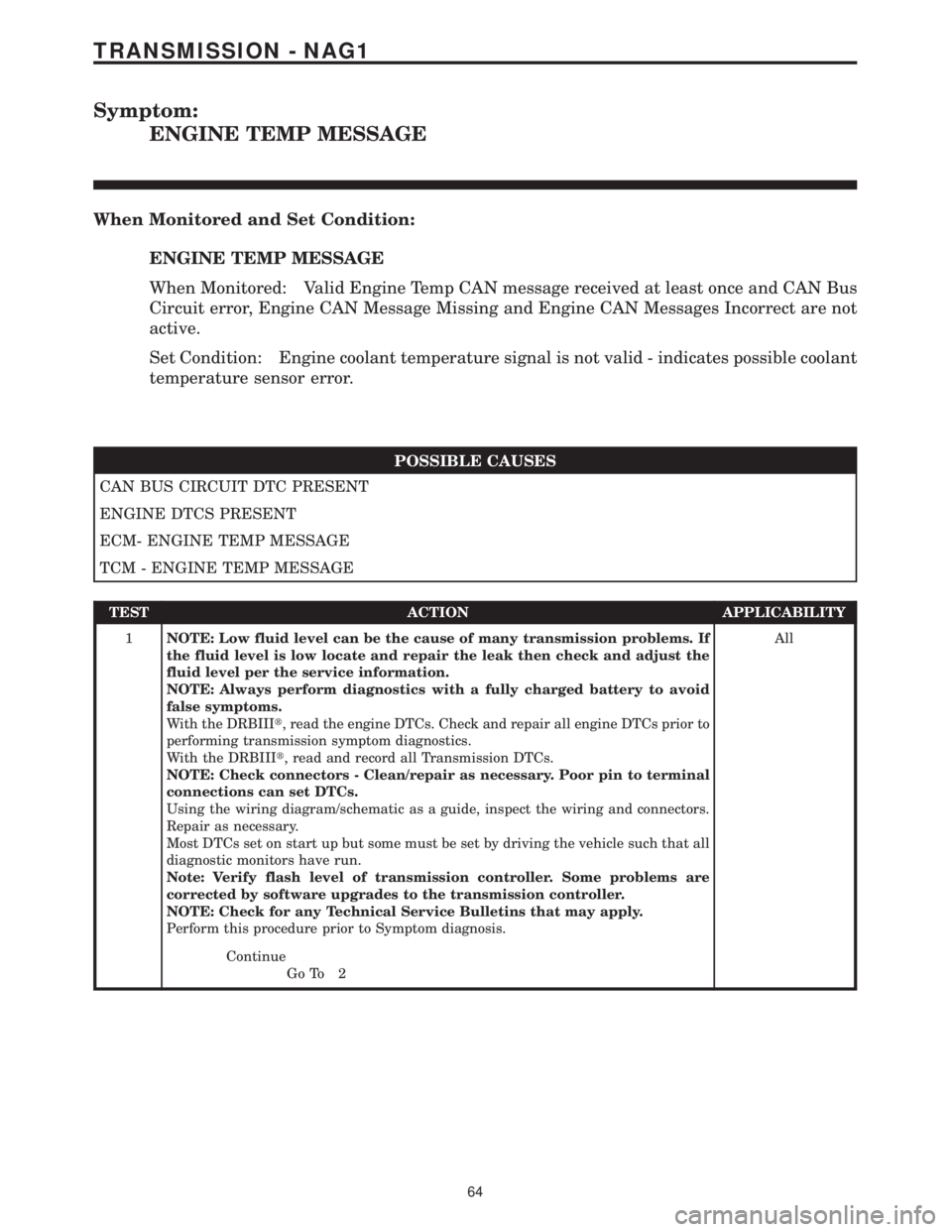
Symptom:
ENGINE TEMP MESSAGE
When Monitored and Set Condition:
ENGINE TEMP MESSAGE
When Monitored: Valid Engine Temp CAN message received at least once and CAN Bus
Circuit error, Engine CAN Message Missing and Engine CAN Messages Incorrect are not
active.
Set Condition: Engine coolant temperature signal is not valid - indicates possible coolant
temperature sensor error.
POSSIBLE CAUSES
CAN BUS CIRCUIT DTC PRESENT
ENGINE DTCS PRESENT
ECM- ENGINE TEMP MESSAGE
TCM - ENGINE TEMP MESSAGE
TEST ACTION APPLICABILITY
1NOTE: Low fluid level can be the cause of many transmission problems. If
the fluid level is low locate and repair the leak then check and adjust the
fluid level per the service information.
NOTE: Always perform diagnostics with a fully charged battery to avoid
false symptoms.
With the DRBIIIt, read the engine DTCs. Check and repair all engine DTCs prior to
performing transmission symptom diagnostics.
With the DRBIIIt, read and record all Transmission DTCs.
NOTE: Check connectors - Clean/repair as necessary. Poor pin to terminal
connections can set DTCs.
Using the wiring diagram/schematic as a guide, inspect the wiring and connectors.
Repair as necessary.
Most DTCs set on start up but some must be set by driving the vehicle such that all
diagnostic monitors have run.
Note: Verify flash level of transmission controller. Some problems are
corrected by software upgrades to the transmission controller.
NOTE: Check for any Technical Service Bulletins that may apply.
Perform this procedure prior to Symptom diagnosis.All
Continue
Go To 2
64
TRANSMISSION - NAG1
Page 2231 of 2305
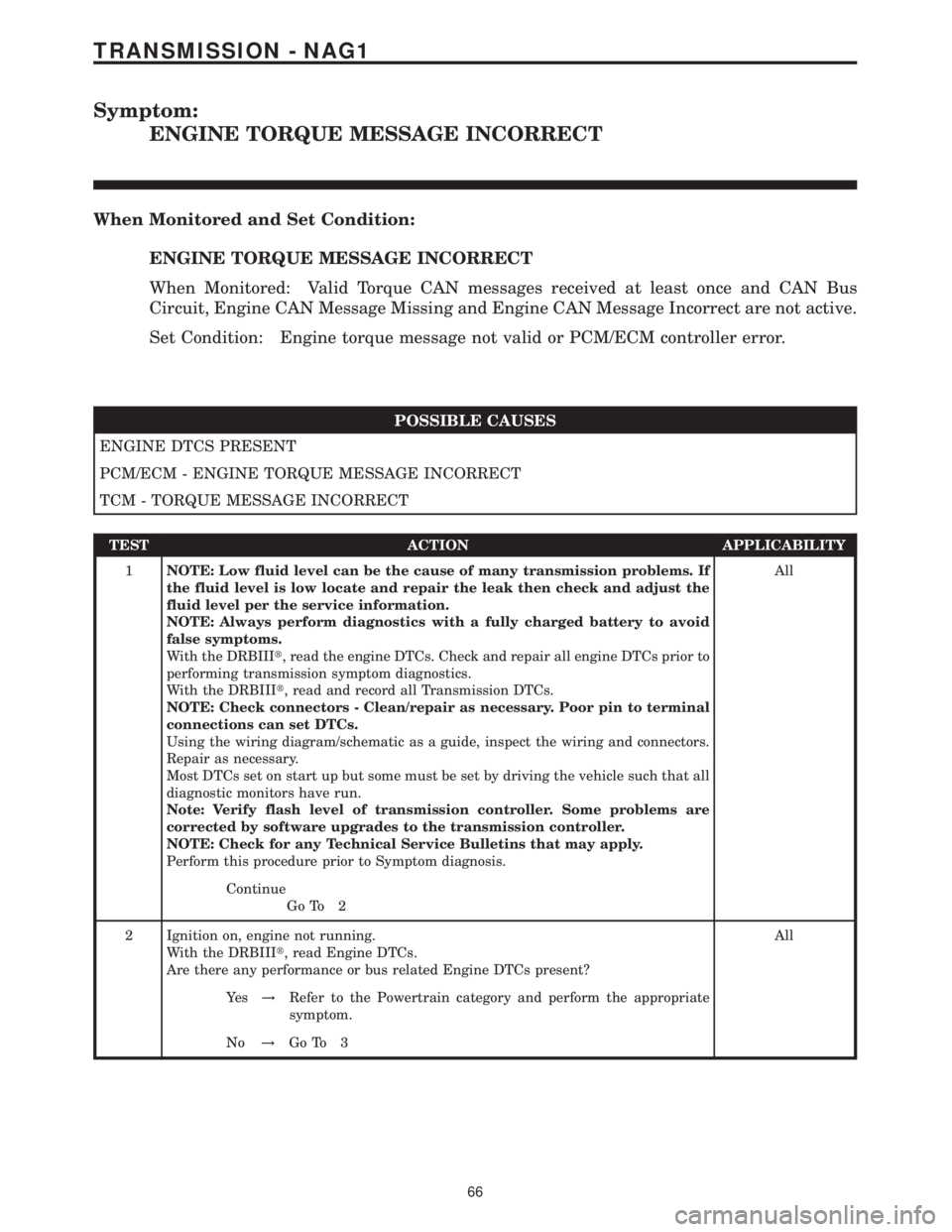
Symptom:
ENGINE TORQUE MESSAGE INCORRECT
When Monitored and Set Condition:
ENGINE TORQUE MESSAGE INCORRECT
When Monitored: Valid Torque CAN messages received at least once and CAN Bus
Circuit, Engine CAN Message Missing and Engine CAN Message Incorrect are not active.
Set Condition: Engine torque message not valid or PCM/ECM controller error.
POSSIBLE CAUSES
ENGINE DTCS PRESENT
PCM/ECM - ENGINE TORQUE MESSAGE INCORRECT
TCM - TORQUE MESSAGE INCORRECT
TEST ACTION APPLICABILITY
1NOTE: Low fluid level can be the cause of many transmission problems. If
the fluid level is low locate and repair the leak then check and adjust the
fluid level per the service information.
NOTE: Always perform diagnostics with a fully charged battery to avoid
false symptoms.
With the DRBIIIt, read the engine DTCs. Check and repair all engine DTCs prior to
performing transmission symptom diagnostics.
With the DRBIIIt, read and record all Transmission DTCs.
NOTE: Check connectors - Clean/repair as necessary. Poor pin to terminal
connections can set DTCs.
Using the wiring diagram/schematic as a guide, inspect the wiring and connectors.
Repair as necessary.
Most DTCs set on start up but some must be set by driving the vehicle such that all
diagnostic monitors have run.
Note: Verify flash level of transmission controller. Some problems are
corrected by software upgrades to the transmission controller.
NOTE: Check for any Technical Service Bulletins that may apply.
Perform this procedure prior to Symptom diagnosis.All
Continue
Go To 2
2 Ignition on, engine not running.
With the DRBIIIt, read Engine DTCs.
Are there any performance or bus related Engine DTCs present?All
Ye s!Refer to the Powertrain category and perform the appropriate
symptom.
No!Go To 3
66
TRANSMISSION - NAG1
Page 2233 of 2305
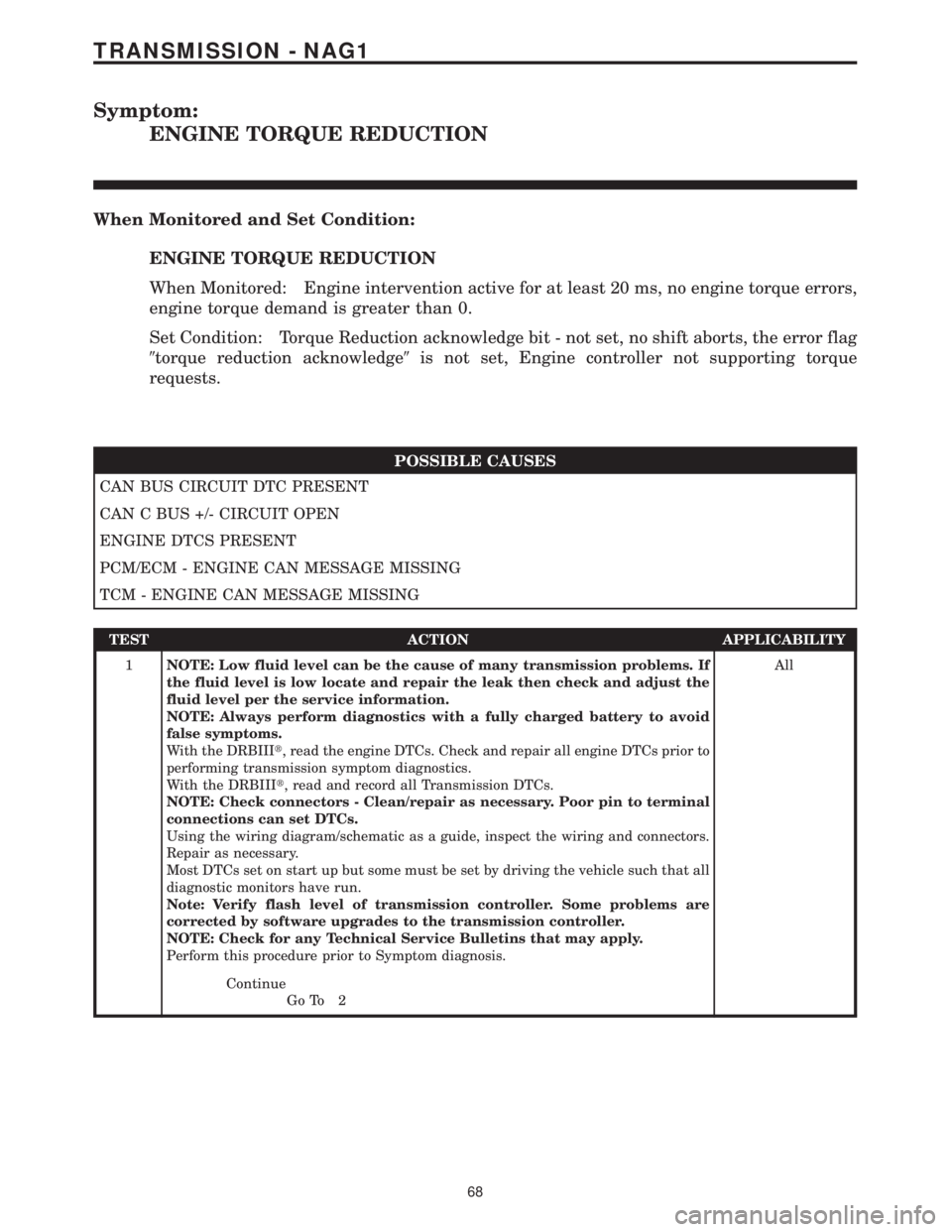
Symptom:
ENGINE TORQUE REDUCTION
When Monitored and Set Condition:
ENGINE TORQUE REDUCTION
When Monitored: Engine intervention active for at least 20 ms, no engine torque errors,
engine torque demand is greater than 0.
Set Condition: Torque Reduction acknowledge bit - not set, no shift aborts, the error flag
9torque reduction acknowledge9is not set, Engine controller not supporting torque
requests.
POSSIBLE CAUSES
CAN BUS CIRCUIT DTC PRESENT
CAN C BUS +/- CIRCUIT OPEN
ENGINE DTCS PRESENT
PCM/ECM - ENGINE CAN MESSAGE MISSING
TCM - ENGINE CAN MESSAGE MISSING
TEST ACTION APPLICABILITY
1NOTE: Low fluid level can be the cause of many transmission problems. If
the fluid level is low locate and repair the leak then check and adjust the
fluid level per the service information.
NOTE: Always perform diagnostics with a fully charged battery to avoid
false symptoms.
With the DRBIIIt, read the engine DTCs. Check and repair all engine DTCs prior to
performing transmission symptom diagnostics.
With the DRBIIIt, read and record all Transmission DTCs.
NOTE: Check connectors - Clean/repair as necessary. Poor pin to terminal
connections can set DTCs.
Using the wiring diagram/schematic as a guide, inspect the wiring and connectors.
Repair as necessary.
Most DTCs set on start up but some must be set by driving the vehicle such that all
diagnostic monitors have run.
Note: Verify flash level of transmission controller. Some problems are
corrected by software upgrades to the transmission controller.
NOTE: Check for any Technical Service Bulletins that may apply.
Perform this procedure prior to Symptom diagnosis.All
Continue
Go To 2
68
TRANSMISSION - NAG1
Page 2235 of 2305
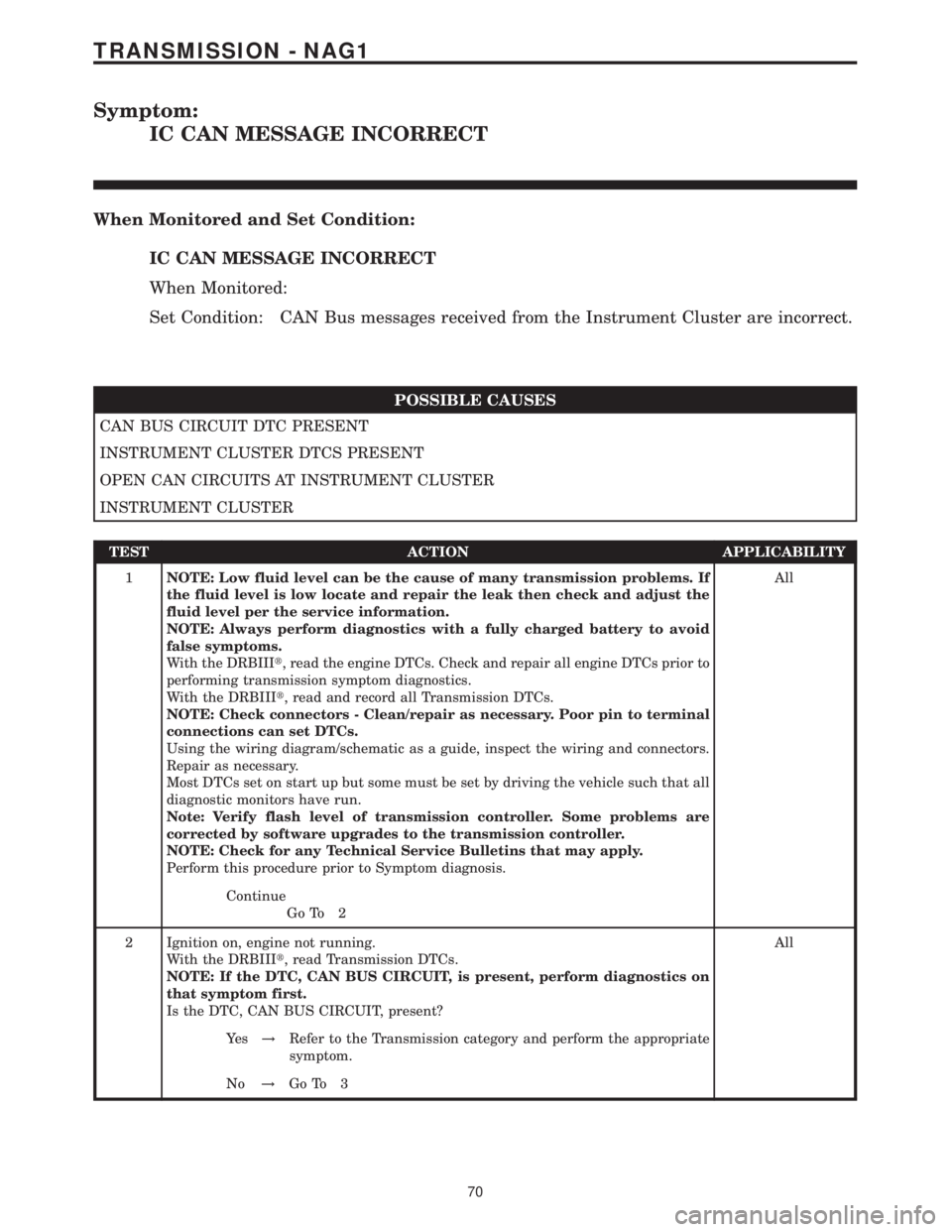
Symptom:
IC CAN MESSAGE INCORRECT
When Monitored and Set Condition:
IC CAN MESSAGE INCORRECT
When Monitored:
Set Condition: CAN Bus messages received from the Instrument Cluster are incorrect.
POSSIBLE CAUSES
CAN BUS CIRCUIT DTC PRESENT
INSTRUMENT CLUSTER DTCS PRESENT
OPEN CAN CIRCUITS AT INSTRUMENT CLUSTER
INSTRUMENT CLUSTER
TEST ACTION APPLICABILITY
1NOTE: Low fluid level can be the cause of many transmission problems. If
the fluid level is low locate and repair the leak then check and adjust the
fluid level per the service information.
NOTE: Always perform diagnostics with a fully charged battery to avoid
false symptoms.
With the DRBIIIt, read the engine DTCs. Check and repair all engine DTCs prior to
performing transmission symptom diagnostics.
With the DRBIIIt, read and record all Transmission DTCs.
NOTE: Check connectors - Clean/repair as necessary. Poor pin to terminal
connections can set DTCs.
Using the wiring diagram/schematic as a guide, inspect the wiring and connectors.
Repair as necessary.
Most DTCs set on start up but some must be set by driving the vehicle such that all
diagnostic monitors have run.
Note: Verify flash level of transmission controller. Some problems are
corrected by software upgrades to the transmission controller.
NOTE: Check for any Technical Service Bulletins that may apply.
Perform this procedure prior to Symptom diagnosis.All
Continue
Go To 2
2 Ignition on, engine not running.
With the DRBIIIt, read Transmission DTCs.
NOTE: If the DTC, CAN BUS CIRCUIT, is present, perform diagnostics on
that symptom first.
Is the DTC, CAN BUS CIRCUIT, present?All
Ye s!Refer to the Transmission category and perform the appropriate
symptom.
No!Go To 3
70
TRANSMISSION - NAG1
Page 2237 of 2305
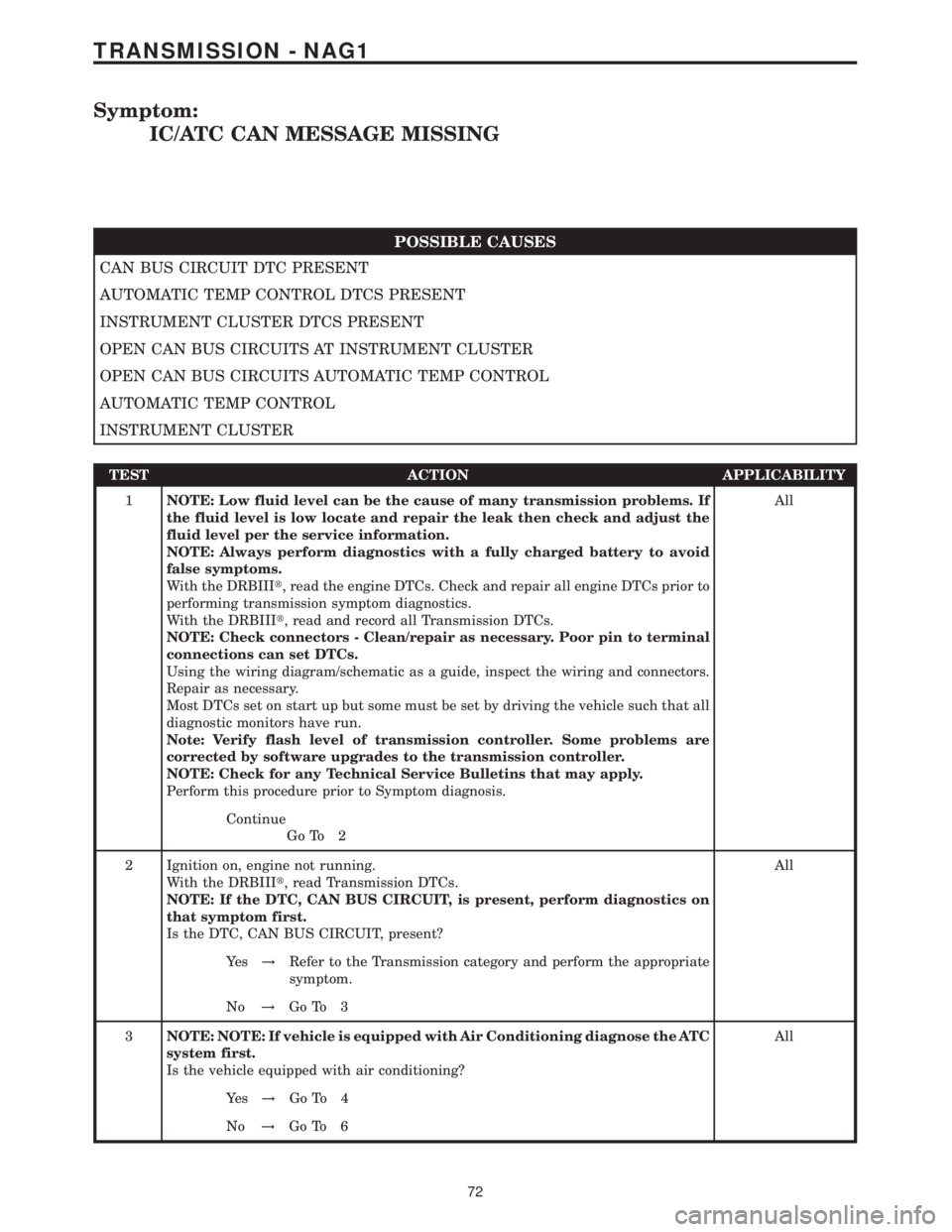
Symptom:
IC/ATC CAN MESSAGE MISSING
POSSIBLE CAUSES
CAN BUS CIRCUIT DTC PRESENT
AUTOMATIC TEMP CONTROL DTCS PRESENT
INSTRUMENT CLUSTER DTCS PRESENT
OPEN CAN BUS CIRCUITS AT INSTRUMENT CLUSTER
OPEN CAN BUS CIRCUITS AUTOMATIC TEMP CONTROL
AUTOMATIC TEMP CONTROL
INSTRUMENT CLUSTER
TEST ACTION APPLICABILITY
1NOTE: Low fluid level can be the cause of many transmission problems. If
the fluid level is low locate and repair the leak then check and adjust the
fluid level per the service information.
NOTE: Always perform diagnostics with a fully charged battery to avoid
false symptoms.
With the DRBIIIt, read the engine DTCs. Check and repair all engine DTCs prior to
performing transmission symptom diagnostics.
With the DRBIIIt, read and record all Transmission DTCs.
NOTE: Check connectors - Clean/repair as necessary. Poor pin to terminal
connections can set DTCs.
Using the wiring diagram/schematic as a guide, inspect the wiring and connectors.
Repair as necessary.
Most DTCs set on start up but some must be set by driving the vehicle such that all
diagnostic monitors have run.
Note: Verify flash level of transmission controller. Some problems are
corrected by software upgrades to the transmission controller.
NOTE: Check for any Technical Service Bulletins that may apply.
Perform this procedure prior to Symptom diagnosis.All
Continue
Go To 2
2 Ignition on, engine not running.
With the DRBIIIt, read Transmission DTCs.
NOTE: If the DTC, CAN BUS CIRCUIT, is present, perform diagnostics on
that symptom first.
Is the DTC, CAN BUS CIRCUIT, present?All
Ye s!Refer to the Transmission category and perform the appropriate
symptom.
No!Go To 3
3NOTE: NOTE: If vehicle is equipped with Air Conditioning diagnose the ATC
system first.
Is the vehicle equipped with air conditioning?All
Ye s!Go To 4
No!Go To 6
72
TRANSMISSION - NAG1
Page 2238 of 2305
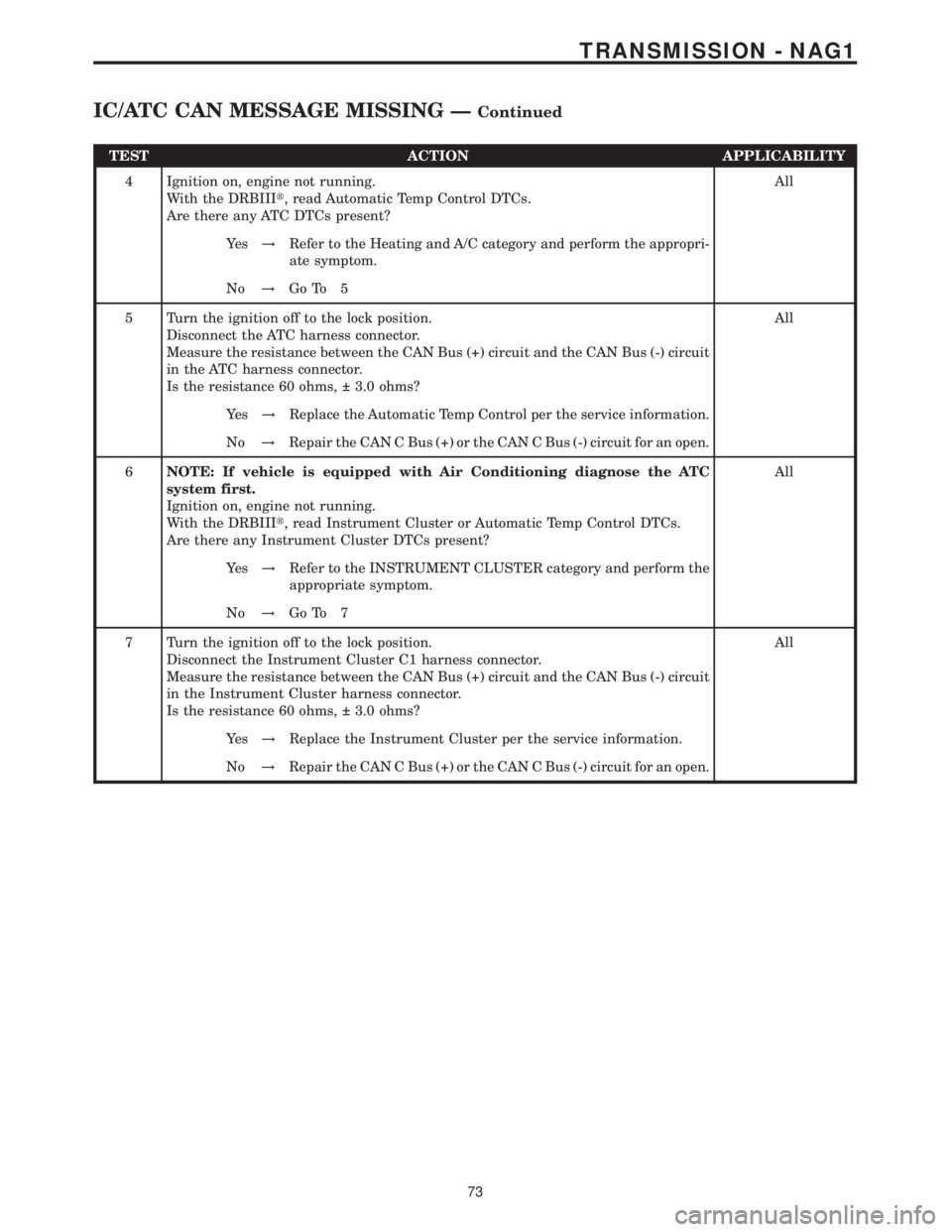
TEST ACTION APPLICABILITY
4 Ignition on, engine not running.
With the DRBIIIt, read Automatic Temp Control DTCs.
Are there any ATC DTCs present?All
Ye s!Refer to the Heating and A/C category and perform the appropri-
ate symptom.
No!Go To 5
5 Turn the ignition off to the lock position.
Disconnect the ATC harness connector.
Measure the resistance between the CAN Bus (+) circuit and the CAN Bus (-) circuit
in the ATC harness connector.
Is the resistance 60 ohms, 3.0 ohms?All
Ye s!Replace the Automatic Temp Control per the service information.
No!Repair the CAN C Bus (+) or the CAN C Bus (-) circuit for an open.
6NOTE: If vehicle is equipped with Air Conditioning diagnose the ATC
system first.
Ignition on, engine not running.
With the DRBIIIt, read Instrument Cluster or Automatic Temp Control DTCs.
Are there any Instrument Cluster DTCs present?All
Ye s!Refer to the INSTRUMENT CLUSTER category and perform the
appropriate symptom.
No!Go To 7
7 Turn the ignition off to the lock position.
Disconnect the Instrument Cluster C1 harness connector.
Measure the resistance between the CAN Bus (+) circuit and the CAN Bus (-) circuit
in the Instrument Cluster harness connector.
Is the resistance 60 ohms, 3.0 ohms?All
Ye s!Replace the Instrument Cluster per the service information.
No!Repair the CAN C Bus (+) or the CAN C Bus (-) circuit for an open.
73
TRANSMISSION - NAG1
IC/ATC CAN MESSAGE MISSING ÐContinued